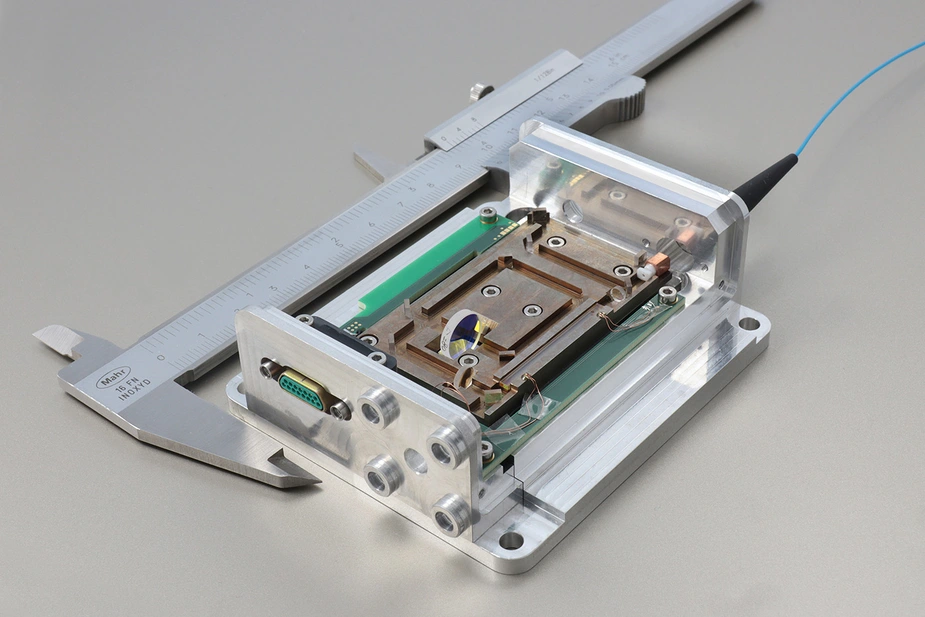FBH presents trends in photonics and quantum technologies at Photonics Days 2024
On October 9 and 10, 2024, the Ferdinand-Braun-Institut will contribute to the Photonics Days Berlin Brandenburg
For two days, experts from research and industry will meet in Berlin Adlershof to discuss current trends in laser technology, heterointegration, microsystems technology, and various other topics. A key focus on October 9 and 10 will be on quantum technologies. Prof. Tim Schröder, who heads the Joint Lab Diamond Nanophotonics at Ferdinand-Braun-Institut (FBH) and Humboldt-Universität zu Berlin (HU Berlin), is chairing the “Berlin Quantum - Quantum Symposium” with four sessions. His aim is to provide an overview of current trends and developments and to establish links between current research and practical industrial application. The co-chairs come from FBH and HU Berlin. Quantum technologies and laser modules are also the subject of the accompanying program during the guided tour through one of FBH’s laboratories.
Dr. Paul Crump, head of the High-Power Diode Lasers Lab at FBH, and his colleagues will also present advances in grating-stabilized diode lasers used to pump fiber lasers. In the “Working in Photonics” session, the High Technology Education and Training Network (ANH Berlin), which is based at FBH, will contribute its many years of experience in securing skilled labor – from career guidance to academic personnel.
At the booth, FBH exhibits will include the following developments:
Compact diode laser module for pumping of fiber lasers for materials processing
Ytterbium-doped fiber lasers address the world’s largest laser market: materials processing. These lasers can be pumped particularly efficiently with a spectrally narrowband source operating at 976 nm, with the pump energy being provided by several fibers with 200 µm core diameter. Demand for innovations in this field continues to be high. Just recently, FBH has developed a novel, particularly simple and potentially cost-effective design – at comparable size and performance. It is based on the FBH’s well-established side-cooled stack design, which is used to efficiently cool innovative double-emitter diode lasers with integrated gratings that stabilize the wavelength. The emitters are stacked vertically, the beam is focused vertically with fast-axis collimation lenses and horizontally with a single cylindrical slow-axis collimation lens. This eliminates the need for several costly elements, such as an external volume Bragg grating for wavelength stabilization and mirrors for beam combing.
Analyzing microplastics in water with entangled photons
In the Sim-QPla project funded by the Federal Ministry of Education and Research (BMBF), the Ferdinand-Braun-Institut is currently developing a miniaturized sensor module that can be used to generate entangled photons and then detect them cost-effectively in a further step. For this purpose, an intense laser beam hits a special crystal inside the module, which ensures that the photons from the laser beam split into entangled photon pairs. The two resulting photons each possess different wavelengths. The photon with the longer wavelength (mid-infrared – MIR) is directed towards a sample and then back into the sensor module. The photon with the shorter wavelength (near infrared – NIR) remains in the module. After an interaction between the two photons and subsequent analysis with a spectrometer, specific plastics can be detected even in the lowest concentrations and sizes. Detection is carried out in the NIR range, in which detectors and cameras are available at lower cost than in the MIR range. The compact size also makes it possible to analyze microplastics in water for the first time mobile and on site.
Photonic integrated circuits – the basis for quantum operations
In order to realize demanding resource states for quantum computing, the Joint Lab Diamond Nanophotonics is investigating how photonic cluster states – a resource for optical quantum computation – with optically active spin defects can be generated. Cavities made of photonic crystals are components that can trap light of certain wavelengths. If an optical quantum system is placed inside the cavity, this amplifies its coupling with the electromagnetic field. These components can therefore be used as efficient interfaces between stationary qubits, the elementary computing and information unit of a quantum computer, and flying photons. Scientists at FBH have successfully fabricated a fully suspended photonic crystal cavity based on a novel “sawfish” design developed by colleagues at HU Berlin. The devices consist of 20 µm long and 275 nm thick diamond beams that are periodically corrugated.
Further information: https://doi.org/10.1063/5.0186509
Contact:
Ferdinand-Braun-Institut gGmbH, Leibniz-Institut für Höchstfrequenztechnik
Gustav-Kirchhoff-Str. 4
12489 Berlin
+49 30 6392-2600
fbh(at)fbh-berlin.de
www.fbh-berlin.de
Press release FBH, 18 September 2024
